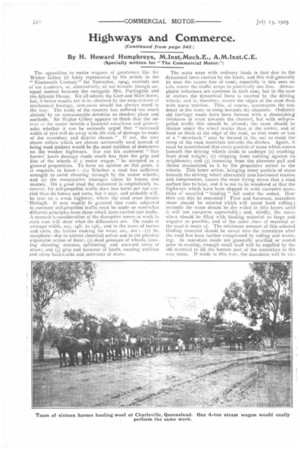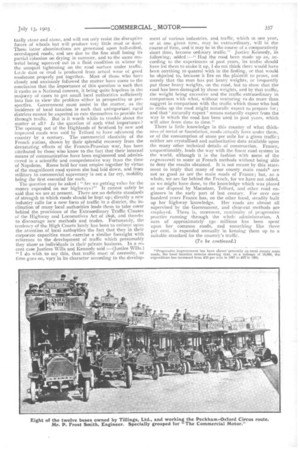Highways and Commerce.
Page 10

Page 11

If you've noticed an error in this article please click here to report it so we can fix it.
(Continued from page 345.)
By H. Howard Humphreys, M.Inst.Mech.E., A./v1.Inst.C.E.
Specially written for "The Commercial Motor.")
The opposition to motor wagons of gentlemen like Sir Walter Galbey (if fairly represented by his article in the " Nineteenth Century " for November, 1904), reminds one of the Luddites, or, alternatively, of me historic though unequal contest between the energetic Mrs. Part ington and the Atlantic Ocean. We all admire the Cart and Shire horse, but, if better results are to be obtained by the employment of mechanical haulage, senement should not always stand in the way, The trade of the country has suffered too much already by an unreasonable devotion to obsolete plant and methods. Sir Walter Gilbey appears to think that the advent of the motor heralds a financial cataclysm and gravely asks whether it can be seriously urged that " increased width of tyre will do away with the risk of damage to roads of the secondary and district classes." If not, the very steam rollers which are almost universally used instead of being road makers would be the most ruthless of destroyers on the weaker highways. Nor can his statement " that horses' hoofs damage roads much less than the grip and bite of the wheels of a -motor wagon " be accepted as a general proposition. To form an opinion on this point, • it is requisite to know :(1) Whether a road has sufficient strength to resist shearing through by the motor wheels; and (2) the comparative tonnages taken by horses and motors. On a good road the statement is emphatically incorrect, for self-propelled traffic does less harm per ton carried than do horses and carts, but it may, and probably will, be true on a weak highway, where the road crust breaks --ThrTaigh. It may readily be granted that roads subjected to constant self-propelled traffic, must be made on somewhat different principles from those which have carried cart traffic. A moment's consideration of the disruptive forces at work in each case will show what the differences are. On roads of average width, say, i4ft to rsit., and in the cases of horses and carts, the factors making for wear, etc., are :—(i) Atmosphere—due to solvent chemical action and to the physical expansion action of frost ; (2) dead pressure of wheels, causing shearing stresses, splintering and outward creep of stone; and (3) grip and hammer of hoofs, causing attrition and creep backwards ded outwards of stone. The main wear with ordinary loads is that due to the dynamical force exerted by the hoofs, and this will generally be near the centre line of road; especially is this seen on mils where the traffic keeps TO practically one line. Atmospheric influences are common in each case, but in the ease of motors the dynamical force is exerted by the driving wheels, and is, therefore, nearer the edges of the road than with horse traction. This of course, accentuates the tendency of the stone to creep towards the channels. Ordinary old carriage roads have been formed with a diminishing thickness of crust towards the channel, but with self-pro. pelled traffic this should he altered; the crust should be thicker under the wheel tracks than at the centre, and at least as thick at the edge of the road, so that more or less of a " skewback " may be formed in the soil to resist the. creep of the road materials towards the ditches. Again, it must be remembered that every particle of stone which comes beneath the driving wheels tends to undergo (1) crushing from dead weight ; (2) chipping from rubbing against its neighbours; and (3) loosening from the alternate pull and thrust transmitted to it by the propulsive action in the wheels. This latter action, bringing every particle of stone beneath the driving wheel alternately into horizontal tension and compression, causes the most trying stress that a road surface has to bear, and it is not to be wondered at that the highways which have been slopped in with excessive quantities of so-called " binding " fail under the ordeal. How then can this be remedied ? First and foremost, macadam stone should be selected which will stand hard rolling ; secondly the stone shouLe be dry roiled in thin layers unfit it will not compress appreciably; and, thirdly, the interstices should be filled With binding material as large and angular as possible, and of the same class of material as the road is made of. The minimum amount of this selected binding material should be swept into the interstices after the road has been further compressed by rolling and watering. As macadam roads are generally scarified or scored prior to coating, enough small stuff wilt be supplied by the old material to fill the bottom part of the interstices in the -nese stone. If made in this way, the macadam will be yir
tually stone and stone, and will not only resist the disruptive forces of wheels but will produce very little mud or dust. These latter abominations are generated upon half-rolled, overslopped roads, and are due to the fine stuff losing its partial cohesion on drying in summer, and to the same material being squeeyed out in a fluid condition in winter by the unequal tightening on the road surface under traffic. Litcle dust or mud is produced from actual %%ear of good roadstone properly put together. Most of those who have closely and anxiously followed the matter have come to the conclusion that the importance of this question is such that it ranks as a National concern, it being quite hopeless in the majority of cases to get small local authorities sufficiently into line to view the problem either in prospective or perspective. Government must assist in the matter, as the incidence of local taxation is such that unimportant rural districts cannot be expected to rate themselves to provide for through traffic. But is it worth while to trouble about the matter at all? Is the question of such vital importance? The opening out of the Highlands of Scotland by new and improved roads was said by Telford to have advanced the country by a century. The commercial elasticity of the French nation, shown by their splendid recovery from the devastating effects of the Franco-Prussian war, has been attributed by those who know to the fact that their internal means of communication have been engineered and administered in a scientific and comprehensive way from the time of Napoleon. Rome held her vast empire together by virtue of the magnificent road system she had laid down, and from military to commercial supremacy is not a far cry, mobility being the first essential for each.
The question may be asked : "Are we getting value for the money expended on our highways?" It cannot safely be said that we are at present. There are no definite standards of strength to which roads should be kept up; directly a new industry calls for a new form of traffic in a district, the inclination of many local authorities leads them to take cover behind the provisions of the Extraordinary Traffic Clauses of the Highway and Locomotives Act of 1848, and thereby to discourage new methods and trades. Fortunately, the tendency of the High Courts lately has been to enforce upon the attention of local authorities the fact that they in their corporate capacities must exercise a similar foresight with reference to the development of traffic which presumably they show as individuals in their private business. In a recent case Justices Wills and Kennedy said :--(Justice Wills.) " I do wish to say this, that, traffic must of necessity, as time goes on, vary in its character according to the develop
ment of various industries, and traffic, which in one year, or at one given time, may be extraordinary, will in the course of time, and it may be in the course of a comparatively short time, become ordinary traffic." Justice Kennedy, in
following, added Had the road been made up as, according to the experiences of past years, its traffic should have led them to make it up, I do not think there would have been anything to quarrel with in the finding, or that would be objected to, because it lies on the plaintiff to prove, not merely that the man has put heavy weights, or frequently put those heavy weights, on the road, but to show that the road has been damaged by those weights, and by that traffic, the weight being excessive and the traffic extraordinary in comparison with what, without venturing to do more than suggest in comparison with the traffic which those who had to make up the road might naturally expect to prepare for; and that 'naturally expect ' means naturally expect from the way in which the road has been used in past years, which will alter from time to time."
There is little knowledge in this country of what thickness of metal or foundation, roads actually have under them, or of the consumption of stone per mile for a given traffic ; neither are crystallised and authoritative data available upon the many other technical details of construction. France, unquestionably, leads the way with the finest road system in the world, although it is the fashion with some of the cognoscenti to sneer at French methods without being able to deny the results obtained. It is not meant by this statement to imply that many of our county main roads* are not as good as are the main roads of France ; but, as a whole, we are far behind the French, for we have not added, as we might have done, to the knowledge which was placed at our disposal by Macadam, Telford, and other road engineers in the early part of last century. For over one hundred years France has, on the other hand, steadily built up her highway knowledge. Her roads are almost all supervised • by the Government, and clear-cut methods are employed. There is, moreover, continuity of progressive practice running through the whole administration. A sum of approximately Teo millions has been spent upon her common roads, and something like three per cent, is expended annually in keeping them up to a suitable standard for the country's traffic.


















